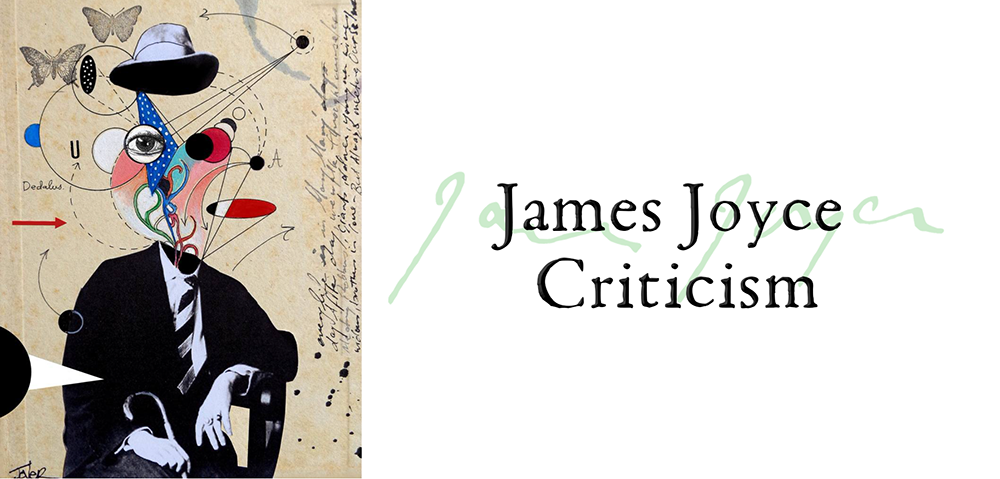Joyce Criticism: General 2: 1980-1999
- At March 17, 2022
- By Great Quail
- In Joyce
 0
0
General Joyce Criticism: 1980-1999
The works profiled below offer criticism about Joyce and his writing, rather than focusing on any specific novel. The books are listed by publication date. Clicking a cover image takes you to Amazon.com. When Brazen Head commentary is unavailable, the publisher’s summaries are usually reprinted. Many of these profiles contain links to detailed reviews published in the James Joyce Quarterly or other academic journals. Unfortunately, most of these are gated behind a JSTOR or Project MUSE paywall. If any knowledgeable Joyce reader would like to review, summarize, or provide additional information for any of these “uncommented” books, please drop us a line! Additional “general” criticism may be found by clicking the links below.
General Joyce Criticism
[Main Page | Criticism 1924-1979 | Criticism 1980-1999 | Criticism 2000-2019 | Criticism 2020-Present]
Who’s He When He’s at Home: A James Joyce Directory
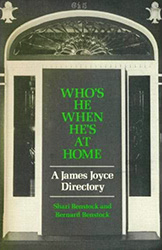
Who’s He When He’s at Home: A James Joyce Directory
By Shari Benstock & Bernard Benstock
University of Illinois Press, 1980
Available online at: Internet Archive
In 1956 Adaline Glasheen published A Census of Finnegans Wake, an alphabetical index of the many mythical, historical, and fictitious figures found in the Wake, with biographical notes and cross references to the various mutated alterations of their names. Glasheen continued to refine her work over the next twenty years, publishing the Third Census of Finnegans Wake in 1977. (And even then she was unable to resolve some of her famous “asterisks,” as she described with characteristic honesty and bluntness: “An asterisk means I don’t know who somebody is.”) A few years layer, Shari and Benjamin Benstock extended Glasheen’s project to encompass the entirety of Joyce’s work from Stephen Hero to Ulysses. While their entries are generally less detailed than Glasheen’s, they’re also working with less obscure texts than Finnegans Wake, so generally get right to the point.
The directory is divided into two sections. The first annotates names from “A.E.” to “ZOLA, ÉMIL.” While this is certainly useful, modern students are more likely to search the Internet, or refer to Gifford’s Ulysses Annotated, which has thankfully remained in print. The second section is more interesting, and possibly more useful: “Anonymous Listings.” These entries consist of unnamed references to people, whether voiced, thought, or in the case of “Circe,” imagined. The listings include epithets: “(adulterer, onehandled)…148, 150…see Nelson, Admiral Lord Horatio,” references to characters already mentioned: “girl…whose laughter Stephen hears with torment…P 115,” or generalized categories: “(‘policeman’)…incapable of poetry, according to Bloom…116.” Many of these are actually quite funny, whether intentionally or not: “(‘bitch, little’)….whom Molly suspects was with Bloom on 16 June…739, 773.” (The inconsistent parenthesis and quotation marks denote whether the reference is a nickname, was voiced aloud, was merely thought, etc.)
Who’s He When He’s at Home concludes with three appendices: “The Joycean Method of Cataloguing,” “Molly’s Masculine Pronouns,” and a “Table of Corresponding Pages.” The middle appendix is the most interesting, as the authors attempt to wade through Molly’s kaleidoscopic references to men in “Penelope” and pin down exactly which man belongs to which he, him, and his! It also offers “Explanations of Controversial Decisions,” such as: “Boylan. Page 769, Line 39. Molly may be maliciously contemplating shocking Bloom by shaving her pubic hair, but it seems more likely that it is her lover for whom this audacious intimacy is intended.”
Joyce Between Freud and Jung
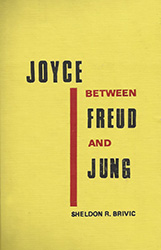
Joyce Between Freud and Jung
By Sheldon Brivic
Kennikat Press, 1980
Available online at: Internet Archive
Sheldon Brivic is an English professor at Temple University. A lifelong Joycean, he’s written six books about Joyce, most of them examining his work through the psychological theories of Freud, Jung, and Lacan. In the introduction of Joyce Between Freud and Jung Brivic states his goals: “In my effort to trace the nature and development of Joyce’s mind as reflected in his work, I will first use Freudian insights to show how Joyce’s mind was formed and to explore its unconscious aspect. Then I will show the relation between these influences and Joyce’s conscious, mature ideas, which I’ll explain partly in Jungian terms.” Portrait and Ulysses are given the lion’s share of Brivic’s attention. He’d later devote an entire book to Finnegans Wake, published in 1995 as Joyce’s Waking Women.
Contents:
Introduction: Joyce in Progress
Part One: Stephen Oedipus
1. The Grave of Boyhood
2. Cork
3. Circles of Supererogation
4. Art
5. Flight
Part Two: Distant Music
6. “The Dead”
7. Exiles: Living Wounded Doubt
Part Three: The Unquiet Father
8. From Stephen to Bloom
9. Joyce’s System and Jung’s Types
10. Love as Creation in Ulysses
11. Shame’s Voice
12. Onanymous Letters
The Wake as Conclusion
Joyce’s Politics
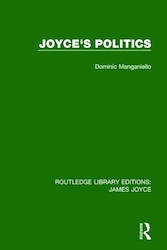
Joyce’s Politics
By Dominic Manganiello
Routledge, 1980
Reprint: Routledge, 2016
Publisher’s Description (2016 Reprint): The object of this study, first published in 1980, is to dispel the view that James Joyce had no political views. Although not a political novelist like D. H. Lawrence or Joseph Conrad, political issues and discussions are central to Joyce’s major novels. This title links that political content with Joyce’s own views, and examines the evolution of those views and attitudes. A number of unusual and fascinating sources for Joyce’s thought are uncovered. Joyce’s Politics is thus a thorough review of a neglected aspect of Joyce and his writings, and will be of interest to students of literature.
Contents:
- Old Ireland
- A Portrait of the Artist as a Young Parnellite
- Literature and the National Consciousness
- Young Europe
- Trieste
- Rome
- Perspectives: Socialism and Anarchism
- “A Portrait of the Artist”
- Stephen Hero
- Dubliners
- Ulysses
- The National Scene
- Ourselves, oursouls alone
- “Zürichschicken:” Waging the Inkbattle
- “The Reawakening”
- Forged Documents
- Literary Politics
- Dublin’s Dante
- “Creeping Jesus”
- The Impossibilities of Siegfried Bakoonin
- Literature and the Conscience
- The Soul of the Artist Under Anarchism
- Finnegans Wake: “Anarxaquy” and the Eternal Struggle
- The Reaction to Fascism
The Aesthetics of Chaosmos: The Middle Ages of James Joyce
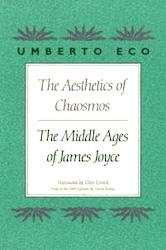
The Aesthetics of Chaosmos: The Middle Ages of James Joyce
By Umberto Eco
First English Edition: University of Tulsa Press, 1982
Expanded Edition: Harvard University Press, 1989
Available online at: Internet Archive
One of Eco’s first published works, this book has gone through numerous transformations. It started life in 1962 as “Le poetiche di Joyce,” the final chapter in Eco’s seminal book, Opera aperta, translated as The Open Work. In 1966 Eco revised the chapter and published it separately as Le poetiche di Joyce: dalla “summa” al “Finnegans Wake.” It was revised again in preparation for translation into English by Ellen Esrock. Published in 1982 by the University of Tulsa, the book was now titled The Aesthetics of Chaosmos. In 1989, Eco made more revisions, and added material from a 1969 lecture at Tulsa University. This final iteration was published by Harvard University Press as The Aesthetics of Chaosmos: The Middle Ages of James Joyce.
Publisher’s Description: For Eco, Joyce’s work is the most powerful, radical, and influential embodiment of tendencies that dominate the literature and art of our time—tendencies eloquently described by Eco in The Open Work. Finnegans Wake in particular is for Eco the “open” work par excellence: it is not about a particular subject, for a wide variety of potential meanings coexist in it—none of them dominant. This modernist text presents a field of possibilities and allows the reader to decide what approach to take. In addition to providing further illustration of the main theme of The Open Work, The Aesthetics of Chaosmos makes a clear analogy between Joyce’s artistic development, as Eco sees it, and Eco’s own personal history. What interests Eco most is Joyce’s move from a Catholic, Thomist position to the disordered, decentered, anarchic vision of life that characterizes Ulysses and Finnegans Wake and is the central characteristic of an “open” work. Yet Eco finds in Joyce’s mature work a nostalgia for the ordered world of medieval thought that is most notably expressed in the symbolic correspondence underlying the surface chaos of Ulysses; Ulysses, he suggests, is a “Thomist summa turned upside down.” Eco began his own writing career in a “spirit of adherence to the religious world of Thomas Aquinas,” a spirit he subsequently lost. Yet a similar nostalgia has expressed itself in occasional excursions into the Middle Ages, culminating in The Name of the Rose, but also apparent in his interest in semiotics. It stands as a lively claim for Joyce’s preeminence in modernist literature, and it also provides a key to Eco’s own literary aesthetic and intellectual development.
James Joyce: New Perspectives
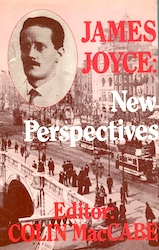
James Joyce: New Perspectives
Edited by Colin MacCabe
Harvester Press, 1982
Available online at: Internet Archive
Publisher’s Description: This authoritative volume, marking the centenary of one of this century’s most innovative writers, covers all aspects of Joyce’s writing and each of his works, from Dubliners through to Finnegans Wake. It constitutes a major reconsideration of Joyce, which has important theoretical implications in terms of language, sexuality and politics for any study of literature. Colin MacCabe has brought together some of the world’s leading authorities on Joyce—among them Fritz Senn, Maria Jolas, Stephen Heath and Raymond Williams—to celebrate and examine Joyce’s investigations of language and narrative. All of Joyce’s texts are considered in terms of the relation between subjectivity and discourse. The value of the collection lies in its insistence that Joyce’s writing breaks with the paralyzed repetition of sexual and political stereotypes by introducing us to a radical experience of writing.
Contents:
- Fritz Senn, “Righting Ulysses”
- Colin MacCabe, “An Introduction to Finnegans Wake”
- Jean-Michel Rabaté, “Silence in Dubliners”
- Maud Ellmann, “Polytropic Man: Paternity, Identity, and Naming In The Odyssey and A Portrait of the Artist as a Young Man”
- Raymond Williams, “Exiles”
- Colin MacCabe, “The Voice of Esau: Stephen in the Library”
- Stephen Heath, “Joyce in Language”
- Patrick Parrinder, “The Strange Necessity: James Joyce’s Rejection in England (1914–1930)”
- Seamus Deane, “Joyce and Nationalism”
- Maria Jolas, “The Joyce I Knew and the Women Around Him”
Women In Joyce
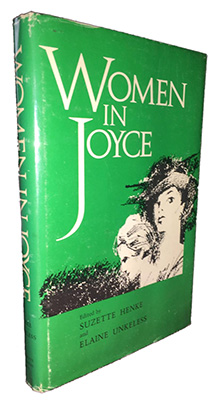
Women In Joyce
Edited by Suzette Henke & Elaine Unkeless
University of Illinois Press, 1982
This collection of essays was the first to focus solely on Joyce’s treatment of women in his fiction. Visitors looking for more information about this collection are invited to read Mary Power’s review published in the James Joyce Quarterly.
Contents:
- Robert Boyle, “The Woman Hidden in James Joyce’s Chamber Music”
- Florence L. Walzl, “Dubliners”
- Bonnie Kime Scott, “Emma Clery in Stephen Hero”
- Suzette Henke, “Stephen Dedalus and Women”
- Ruth Bauerle, “Bertha’s Role in Exiles”
- Suzette Henke, “Gerty MacDowell”
- Elaine Unkeless, “The Conventional Molly Bloom”
- Shari Benstock, “The Genuine Christine”
- Margot Norris, “Anna Livia Plurabelle”
Joyce and Feminism
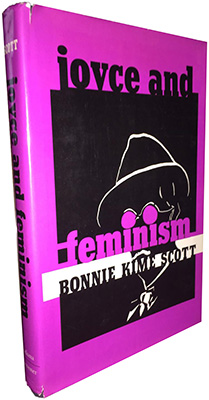
Joyce and Feminism
By Bonnie Kime Scott
Indiana University Press, 1984
From 1975-2001, Bonnie Kime Scott was an English professor at the University of Delaware. She then moved to San Diego State University’s Department of Women’s Studies, which she chaired from 2005 until her retirement in 2011. She specializes in Virginia Woolf and Modernism. Joyce and Feminism is Scott’s first full-length analysis of James Joyce. The first part of the book is devoted to a general feminist critique of Joyce and his writing. The latter portion is devoted to individual analyses of three Joycean characters: Emma Clery from A Portrait of the Artist as a Young Man, Molly Bloom from Ulysses, and Issy from Finnegans Wake. A few years later Scott would publish James Joyce (Feminist Readings), in which she’d expand these case studies to include Gretta Conroy, Bertha Rowan, Beatrice Justice, Gerty MacDowell, and Anna Livia Plurabelle.
Publisher’s Description: Shifting from contexts, to individuals, to texts, Bonnie Kime Scott provides the reader with a re-vision of women and Joyce. She develops a feminist framework for approaching Joyce, which allows for the mutual communication of conventional and feminist critics, and evaluates his sensitivity to the problems of real women in life and fiction and discusses the evolution of his work from early, realistic depictions to late recreations of the goddess.
Contents:
1. Introduction: Feminist Frameworks for Joyce
2. Mythical, Historical, and Cultural Contexts for Women in Joyce
3. Early Encounters with Feminism: The Irish Feminist Movement and the Literary Feminism of Moore, Shaw, Houptmann, and Ibesn
4. The Female Family of Joyce
5. New Free Women in the Company of Joyce
6. Feminist Critics of Joyce
7. Emma
8. Molly
9. Issy
10. A Joycean Feminist Re-vision
James Joyce
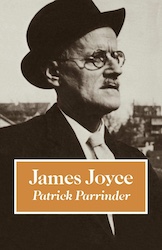
James Joyce
By Patrick Parrinder
Cambridge University Press, 1984
Available online at: Internet Archive
Publisher’s Description: James Joyce holds a unique position in literature. No writer has a higher reputation, none attracts more ardent devotees, and none poses so many difficulties for the first-time reader. This book is an original and well-informed survey of the whole of Joyce’s work. It offers close readings of his early writings such as Dubliners and A Portrait of the Artist as a Young Man, and an extended examination of his masterpiece, Ulysses, as well as a stimulating introduction to that notoriously difficult work Finnegans Wake. Dr Parrinder stresses Joyce’s ambivalent relationship to the Ireland of his youth, and his ability to incorporate the most banal and profane levels of experience and language into profound celebration of the human capacity for survival and regeneration. The Joyce who emerges is a writer of innocence and gusto as well as immense artistic cunning.
A Companion to Joyce Studies
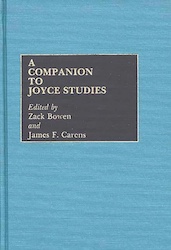
A Companion to Joyce Studies
Edited by Zack R. Bowen & James F. Carens
Greenwood, 1984
Available online at: Internet Archive
From Choice: Nearly 30 years of intense and varied Joyce study has ensued, and it is time for a second stocktaking, one that assesses not only the critical status of each of the works in the canon but addresses as well biographical and aesthetic interests. Bowen and Carens have accomplished this by this collection of essays by 16 authorities, each devoted to a separate subject or work. Each of the essays, averaging 50 pages in length, reviews the critical history of the subject, providing a discursive, selective bibliography as it develops its overview. This Companion [provides] a full and deep review of a century’s work by and of Joyce.
Contents:
- Edmund L. Epstein, “James Augustine Aloysius Joyce”
- Mary T. Reynolds, “Joyce as a Letter Writer”
- Michael Groden, “A Textual and Publishing History”
- Chester G. Anderson, “Joyce’s Verses”
- Florence L. Walzl, “Dubliners”
- Thomas E. Connolly, “Stephen Hero”
- James F. Carens, “A Portrait of the Artist as a Young Man”
- Bernard Benstock, “Exiles”
- Vicki Mahaffey, “Giacomo Joyce”
- Zack Bowen, “Ulysses”
- Patrick A. McCarthy, “The Structures and Meanings of Finnegans Wake”
- Michael H. Begnal, “The Language of Finnegans Wake”
- Barbara DiBernard, “Technique in Finnegans Wake”
- Robert Scholes & Marlena G. Corcoran, “The Aesthetic Theory and the Critical Writings”
- Morris Beja, “Epiphany and the Epiphanies”
- Sidney Feshbach & William Herman, “The History of Joyce Criticism and Scholarship”
- Appendix I: Edmund L. Epstein, “Joyce’s Names”
- Appendix II: Michael Groden, “Library Collections of Joyce Manuscripts”
Joyce the Creator

Joyce the Creator
By Sheldon Brivic
University of Wisconsin Press, 1985
Available online at: Internet Archive
Publisher’s Description: In order to give life to his fiction, according to Sheldon Brivic, James Joyce found it necessary to play the role of a god by designing himself into his texts as an active presence. Attempting to define a Joycean aesthetic that combines theology and psychology, Brivic examines the writer’s struggle to achieve a divine perspective through which his own mind would animate a teeming universe. Brivic’s approach—providing a new understanding both of how Joyce operated as a creator and of the metaphysics involved in constructing human reality—will engage students and scholars of modern fiction, literary criticism, philosophy, religion, and psychology. Joyce activated his characters and creations, Brivic argues, by relating them dynamically to the most complex mental structure he could devise. It was an intricate version of God’s mind—a mind containing minds according to St. Augustine’s Trinitarian conception—that served as model for Joyce’s projection of himself as a multiplicity of narrative voices. Aristotle’s theory of causality is also seen by Brivic as crucial to Joyce’s creative principles.
Joyce’s Anatomy of Culture
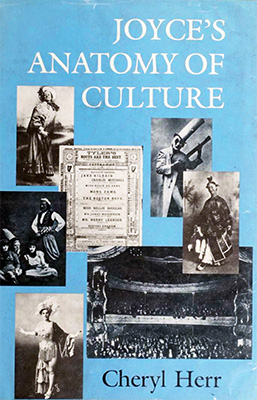
Joyce’s Anatomy of Culture
By Cheryl Herr
University of Illinois Press, 1986
Available online at: Internet Archive
Sidney Feshbach published a review of Joyce’s Anatomy of Culture in the James Joyce Quarterly: “Cheryl Herr’s Joyce’s Anatomy of Culture must be read by all interested in Joyce—critics, teachers, students, and ‘common readers.’ While I disagree with much, I believe the book to be extremely useful, presenting a provocative polemic for reading Joyce in terms of institutions and institutional discourses…”
Publisher’s Description: In this pioneering and provocative study, Herr traces the crucial relations between Irish popular culture and the writings of James Joyce. From Dubliners through Finnegans Wake, Joyce modeled large sections of his work on Irish newspapers, popular stage performances (pantomime, music hall), and sermons. By exploring these influences, Herr illuminates not only Joyce’s aesthetics but also his concern with how popular forms both reflect and affect a culture’s concepts of gender and selfhood, courtship and marriage, family life, social order, national identity, and moral values.
James Joyce: The Centennial Symposium
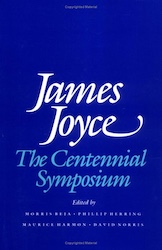
James Joyce: The Centennial Symposium
Edited by Morris Beja, Phillip Herring, Maurice Harmon, and David Norris
University of Illinois Press, 1986
Publisher’s Description: A record-breaking number of Joyceans assembled at the Eighth International James Joyce Symposium in Dublin to celebrate the centenary of his birth. A compilation of the most exciting and valuable presentations from that 1982 conference, this volume includes major addresses by Hugh Kenner and A. Walton Litz and encompasses such topics as Joyce’s work in relation to that of other writers (especially Yeats, Woolf, and Pynchon), aspects of Finnegans Wake, and insightful biographical material.
Contents:
1. The Joyce Connection
William Chace, “Joyce and the Professors”
Seamus Deane, “Masked with Matthew Arnold’s Face: Joyce and Liberalism”
Ellen Carol Jones, moderator: “Yeats and Joyce” (Papers by A. Walton Litz, Giorgio Melchiori, and Richard Ellman)
Karen Lawrence, “Gender and Narrative Voice in Jacob’s Room and A Portrait of the Artist as a Young Man”
Suzette A. Henke, “Virginia Woolf Reads James Joyce: The Ulysses Notebook”
Richard Pearce, “What Joyce after Pynchon?”
David Seed, “Naming in Pynchon and Joyce”
2. Sirens Without Music
Derek Attridge, “Joyce’s Lipspeech: Syntax and the Subject in Sirens”
Maud Ellmann, “To Sing or to Sign”
Daniel Ferrer, “Echo or Narcissus?”
André Topia, “Sirens: The Emblematic Vibratio
Jean-Michel Rabaté, “Silence of the Sirens”
Robert Young, “Language of Flow”
3. Aspects of Finnegans Wake
Bernard Benstock, “Beyond Explication: The Twice-told Tales in Finnegans Wake”
Carol Shloss, “Finnegans Wake as a History of the Book”
Beryl Schlossman, “Finnegans Wake: The Passage Toward Pentecost”
Margot Norris, “Mixing Memory and Desire: The ‘Tristan and Iseult’ Chapter in Finnegans Wake”
Jean-Michel Rabaté, “Narratology and the Subject of Finnegans Wake”
4. Joyce’s Consubstantiality
Sheldon Brivic, “Joyce’s Consubstantiality”
Elliott B. Gose Jr., “Joyce’s Goddess of Generation”
5. Biographical Studies
J.B. Lyons, M.D., “Thrust Syphilis Down to Hell”
Ann McCullough, “Joyce’s Early Publishing History in America”
David Hayman, “Shadow of His Mind: The Papers of Lucia Joyce”
6. Major Addresses
Hugh Kenner, “Signs On a White Field”
A. Walton Litz, “Ulysses and its Audience”
James Joyce (Modern Critical Views)
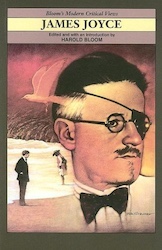
James Joyce (Modern Critical Views)
Edited by Harold Bloom & William Golding
Chelsea House, 1986
Available online at: Internet Archive
Part of Harold Bloom’s “Modern Critical Views” series, this book is a collection of “nineteen critical essays on the Irish writer and his works.” Overall it’s a pretty solid selection, a mix of historical pieces, Joycean stalwarts, and newer mid-century voices. While a thematic organization might have suited the reader better than Bloom’s chronological arrangement, the majority of Joyce’s oeuvre is discussed, including Exiles and his poetry.
Contents:
- Harold Bloom: Introduction
- Samuel Beckett, “Dante… Bruno. Vico.. Joyce”
- S.L. Goldberg, “Homer and the Nightmare of History”
- Richard Ellmann, “Bloom Unbound”
- Anthony Burgess, “The Dublin Sound”
- Harry Levin, “The Ulysses Manuscript”
- Richard Ellmann, “The Consciousness of Joyce”
- Hugh Kenner, “Joyce’s Voices”
- Jennifer Schiffer Levine, “Originality and Repetition in Finnegans Wake and Ulysses”
- Deborah Pope, “The Misprision of Vision: A Portrait of the Artist as a Young Man”
- Mary T. Reynolds, “Paternal Figures and Paternity Themes”
- Karen Lawrence, “Eumaeus: The way of All Language”
- Roland McHugh, “The Finnegans Wake Experience: Samples”
- Frederic Jameson, “Ulysses in History”
- Raymond Williams, “Exiles”
- Gabriele Schwab, “Mollyloquy”
- Francis Warner, “The Poetry of James Joyce”
- William Empson, “Ulysses: Joyce’s Intentions”
- Daniel Ferrer, “Circe, Regret, and Regression”
- Patrick Parrinder, “Dubliners”
James Joyce (Feminist Readings)
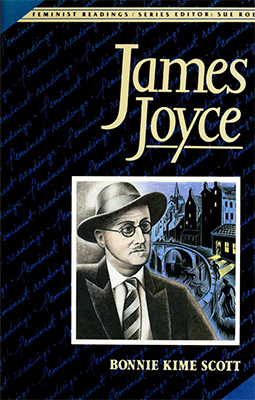
James Joyce (Feminist Readings)
By Bonnie Kime Scott
Humanities Press International, 1987
Available online at: Internet Archive
In her 1984 book Joyce and Feminism, Bonnie Kime Scott devoted three chapters to feminist analysis of individual characters from Joyce’s fiction: Emma Clery from A Portrait of the Artist as a Young Man, Molly Bloom from Ulysses, and Issy from Finnegans Wake. Three years later Scott expanded her study through Sue Roe’s “Feminist Readings” series. According to Scott’s introduction:
The present book offers additional analyses of Joycean women, particularly ones that have been called for by readers of Joyce and Feminism: Gretta Conroy of the story, ‘The Dead’, from Dubliners, Bertha Rowan and Beatrice Justice from the play Exiles, Gerty MacDowell of Ulysses, and ALP, the mother figure of Finnegans Wake. I have extended feminist analysis to male characters, particularly Stephen and Simon Dedalus, in A Portrait and Ulysses. But I am no longer content with character analysis as a representation of feminist theoretical options, or as an approach to Joyce, who broke down traditional concepts of character in Ulysses and Finnegans Wake. Each of chapters 2-5 takes up an issue currently under feminist debate, directing the tools and questions presented toward selected Joyce texts. I call upon, not just one feminist approach, but the variety that is needed to deal both with the issues under discussion, and Joyce’s writing. It would be impossible in a book of this scope to represent the full variety and complex history of feminist theories. But to make the theories I deal with clear conceptually, I have arranged them in a ‘matrix of feminist theory’. As explained in chapter 1, this is appropriate to the ‘plurabilities’ (FW 104.2) of both Joyce and contemporary feminism. The matrix can be used to overlay the human territories (conscious and unconscious, realistic and fantastic, individual and collective) explored by Joyce. By treating such conceptual differences, it clarifies the grounds of disagreements among seemingly rival feminist practices and the interests specific feminist practices share with non-feminist theory.
Contents:
1. Pluralities: Joyce in a Matrix of Feminist Theory
2. The Canon: Challenges to Male-Centered Literature and History
3. Gender, Discourse and Culture
4. Myths of Female Origins
5. Gender, Language and Writing
The Cambridge Companion to James Joyce
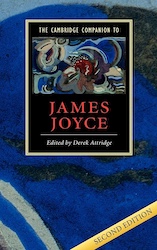
The Cambridge Companion to James Joyce
Edited by Derek Attridge
First Edition: Cambridge University Press, 1990
Second Edition: Cambridge University Press, 2004
Available online at: Internet Archive (1990 Edition)
The Cambridge Companion to James Joyce was published in 1990. It collected eleven essays on Joyce covering a broad range of topics. When it came time for a second edition, the editor Derek Attridge used the opportunity to make extensive revisions. The initial essays were organized into a more consistent thematic approach. The contributions by Christopher Butler and John Paul Riquelme were revised, renamed, and resequenced. Karen Lawrence’s “Joyce and Feminism” was swapped with an essay of the same name by Jeri Johnson. In an attempt to reflect current academic trends, new essays on sexuality, colonialism, and post-Marxism were included. Unsurprisingly, Hans Walter Gabler’s essay was jettisoned. While this could have been for reasons of relevance—for better or for worse, Gabler’s controversial “corrected” Ulysses has become entrenched in academia—there were also valid political reasons. Why pick a side when you don’t have to?
First Edition (1990) Contents:
- Derek Attridge, “Reading Joyce”
- Seamus Deane, “Joyce the Irishman”
- Klaus Reichert, “The European Background of Joyce’s Writing”
- Jean-Michel Rabaté, “Joyce the Parisian”
- John Paul Riquelme, “Stephen Hero, Dubliners and A Portrait of the Artist as a Young Man: Styles of Realism and Fantasy”
- Jennifer Levine, “Ulysses”
- Margot Norris, “Finnegans Wake”
- Vicki Mahaffey, “Joyce’s Shorter Works”
- Hans Walter Gabler, “Joyce’s Text in Progress”
- Karen Lawrence, “Joyce and Feminism”
- Christopher Butler, “Joyce, Modernism and Post-modernism”
Bob R. Bogle offers an extensive review of the 1990 Cambridge Companion on his blog.
Second Edition (2004) Contents:
- Derek Attridge, “Reading Joyce”
- Seamus Deane, “Joyce the Irishman”
- Jean-Michel Rabaté, “Joyce the Parisian”
- Christopher Butler, “Joyce the Modernist”
- Garry Leonard, “Dubliners”
- John Paul Riquelme, “Stephen Hero and A Portrait of the Artist as a Young Man: Transforming the Nightmare of History”
- Jennifer Levine, “Ulysses”
- Margot Norris, “Finnegans Wake”
- Vicki Mahaffey, “Joyce’s Shorter Works”
- Jeri Johnson, “Joyce and Feminism”
- Joseph Valente, “Joyce and Sexuality”
- Jennifer Wicke, “Joyce and Consumer Culture”
- Marjorie Howes, “Joyce, Colonialism, and Nationalism”
James Joyce and the Politics of Desire
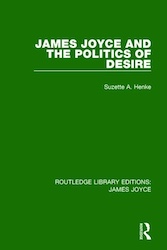
James Joyce and the Politics of Desire
By Suzette A. Henke
Routledge, 1990
Available online at: Internet Archive
Mary Lowe-Evans published a review of James Joyce and the Politics of Desire in the James Joyce Quarterly: “Drawing primarily, but not exclusively, on the theories of Jacques Lacan and Julia Kristeva, Henke sets out to demonstrate that a critic who assumes a skeptical but sympathetic attitude will likely conclude that Joyce’s works subvert the phallocentric authority and logocentric discourse traditionally embraced by Western culture.”
Publisher’s Description: Can Joyce be reclaimed for feminism? How does his writing challenge received ideas about gender roles? How do the innovations of Joyce’s modernist writing relate to recent French feminist and psychoanalytical theories? James Joyce and the Politics of Desire offers the first feminist/psychoanalytic reassessment of the Joycean canon in the wake of Freud, Lacan, and Kristeva. Suzette Henke’s discussion of Ulysses, Dubliners, A Portrait of the Artist, Finnegans Wake, and Exiles centers around issues of desire and language and the politics of sexual difference, raising the question of how far Joyce’s writings undermine the linguistic certainties which prop up western patriarchal culture.
Re-Viewing Classics of Joyce Criticism
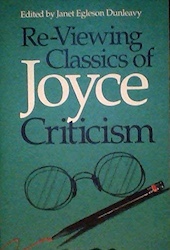
Re-Viewing Classics of Joyce Criticism
Edited by Janet Egleson Dunleavy
University of Illinois Press, 1991
Steven Reese wrote a brief review of this book in Modern Fiction Studies:
In her “Introduction” to Re-Viewing Classics of Joyce Criticism, Janet Egleson Dunleavy recalls, with a belated sigh, the early decades of Joyce studies “when the variety of ideas to be examined was limited only by curiosity, imagination, and a reader’s willingness to find new puzzlement, insights, and delights on every page.” Surely where Joyce is concerned willingness, imagination, and curiosity still count for a good deal, even in that crowded critical territory. And in any case—as this collection of essays suggests—once Joyceans feel they’ve exhausted the primary texts, they will still have one another’s work to occupy them.
Re-Viewing Classics of Joyce Criticism assembles some of the most distinguished Joyce scholars to examine the “pioneer texts” of their predecessors. The essays vary in detail and tone, but in general each summarizes the background out of which a particular study developed, discusses its contemporary reception, reviews its contents and method, and evaluates the text’s enduring contribution to the field. Patrick A. McCarthy’s essay on Stuart Gilbert’s James Joyce’s “Ulysses”: A Study (1930) is a model of the form. McCarthy is especially enlightening on the issue of historical context (a strength of the whole volume), pointing out that Gilbert’s “emphasis on order and control was a response to critics who regarded Ulysses mainly as a formless, chaotic outpouring of experience.” He discusses thoroughly the limitations of Gilbert’s approach but concludes that, despite these, “few books have done as much as Stuart Gilbert’s to direct their readers’ attention to the beauty and integrity of Joyce’s masterful novel.”
The essays are consistently intelligent and engaging, they avoid nitpicking, and they are willing to challenge questionable critical assumptions without undermining their high regard for their subjects. If anything, the writing is too well-mannered, too reserved. Indeed, with the exception of Suzette A. Henke (writing on Our Exagmination round His Factification for Incamination of Work in Progress) and perhaps Morton P. Levitt (writing on Harry Levin’s James Joyce), the writers seem to lack a certain enthusiasm that Joyce himself often inspires in critics. There are, additionally, small imbalances of focus; the discussions of Ellmann and Kenner, for example, are among the shorter of the contributions.
Still, what emerges is just what the volume’s editor describes: “an introduction to the history of Joyce studies as well as to the foundations of much modern criticism.” The essays succeed in giving some shape to a vast and rapidly expanding critical field.
The Veil of Signs: Joyce, Lacan, and Perception
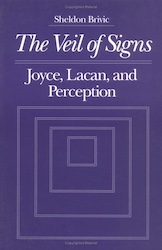
The Veil of Signs: Joyce, Lacan, and Perception
By Sheldon Brivic
University of Illinois Press, 1991
Available online at: Internet Archive
Another offering from Sheldon Brivic, Joyce’s literary psychoanalyst! Michael Walsh published a thoughtful, but critical, review of The Veil of Signs in The Journal of Mind and Behavior: “Lacan called love ‘le sinthome,’ condensing meanings suggesting ‘the symptom’ and ‘the holy man,’ the symptom and the saint. Brivic is right, I think, understanding this to imply that Joyce is the subject of the unconscious who has in his writing most nearly approached mastery of this common human condition However, there is another Lacanian sense in which the unconscious defies mastery in principle; Brivic gives us too much saint and not enough symptom.”
Publisher’s Description: How does perception operate in James Joyce’s fiction? This question is addressed from a unique perspective in The Veil of Signs. Sheldon Brivic uses the theories of Jacque Lacan to create a radically new concept of the mechanics of mental life in the novels, including Ulysses and Finnegans Wake. This is the first book to make use of Lacan’s writings and seminars on Joyce.
Joyce’s Web: The Social Unraveling of Modernism
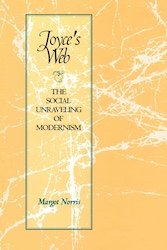
Joyce’s Web: The Social Unraveling of Modernism
By Margot Norris
University of Texas Press, 1992
Publisher’s Description: James Joyce has long been viewed as a literary modernist who helped define and uphold modernism’s fundamental concepts of the artist as martyr to bourgeois sensibilities and of an idealistic faith in artistic freedom. In this revolutionary work, however, Margot Norris proposes that Joyce’s art actually critiques these modernist tenets by revealing an awareness of the artist’s connections to and constraints within bourgeois society. In sections organized around three mythologized and aestheticized figures in Joyce’s works—artist, woman, and child—Norris’ readings “unravel the web” of Joyce’s early and late stories, novels, and experimental texts. She shows how Joyce’s texts employ multiple mechanisms to expose their own distortions, silences, and lies and reveal connections between art and politics, and art and society. This ambitious new reading not only repositions Joyce within contemporary debates about the ideological assumptions behind modernism and postmodernism, but also urges reconsideration of the phenomenon of modernism itself. It will be of interest and importance to all literary scholars.
Mythic Worlds, Modern Words: On the Art of James Joyce
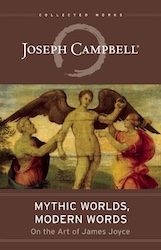
Mythic Worlds, Modern Words: On the Art of James Joyce
By Joseph Campbell; Edited by Edmund L. Epstein
HarperCollins, 1993
Available online at: Internet Archive
Also available as: Brilliance Audiobook
Joseph Campbell (1904-1987) was a celebrated American mythologist, the author of The Hero with a Thousand Faces. He was also a lifelong Joycean, and in 1944 co-authored A Skeleton Key to Finnegans Wake, the first book of Wake scholarship published after Joyce’s final novel hit the shelves in 1939. Edited by Edmund L. Epstein, this book collects Campbell’s many essays on Joyce and his writing, and includes extended pieces on Portrait, Ulysses, and Finnegans Wake along with a critical essay on Thornton Wilder’s The Skin of Our Teeth. These are followed by interview excerpts with Campbell, and an extensive section of notes. While many of Campbell’s ideas about Joyce have been absorbed or superseded by later books, Mythic Worlds, Modern Words offers an interesting window into early Joyce scholarship, and Campbell is always a fascinating writer!
Publisher’s Description: In 1927, as a twenty-three-year-old postgraduate scholar in Paris, Joseph Campbell first encountered James Joyce’s Ulysses. Known for being praised and for kicking up controversy (including an obscenity trial in the United States in 1920), the novel left Campbell both intrigued and confused, as it had many others. Because he was in Paris, he was able to visit the Shakespeare & Company bookstore—the outpost of the original publisher of Ulysses, Sylvia Beach. She gave him “clues” for reading Ulysses, and that, Campbell attested, changed his career. For the next sixty years, Campbell moved through the labyrinths of Joyce’s creations—writing and lecturing on Joyce using depth psychology, comparative religion, anthropology, and art history as tools of analysis. Arranged by Joyce scholar Edmund L. Epstein, Mythic Worlds, Modern Words presents a wide range of Campbell’s writing and lectures on Joyce, which together form an illuminating running commentary on Joyce’s masterworks. Campbell’s visceral appreciation for all that was new in Joyce will delight the previously uninitiated, and perhaps intimidated, as well as longtime lovers of both Joyce and Campbell.
James Joyce and the Question of History
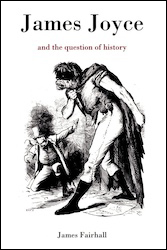
James Joyce and the Question of History
By James Fairhall
Cambridge University Press, 1993
Available online at: Internet Archive
Bob Williams: All that find the works of James Joyce congenial sooner or later so immerse themselves that they inevitably produce valuable considerations. A student of Joyce that has special attainments will be especially favored in the number and worth of those considerations. This is Mr Fairhall’s advantage since he brings to the study of Joyce the discipline of the historiographer and the linguist. He is very serious about history and begins with a discussion of its epistemological difficulties. For him history is a state of awareness that enables us to snatch freedom from necessity. Joyce too had this aim although, as an artist, it was implied rather than explicit and his progressive and persistent explorations of the limits of language and narration modify the idea of historicity. The severity of his interrogations constituted both an artistic exploration and an attack on the political, religious and linguistic obstructions to his creativity.
Mr Fairhall takes up each historical question in—appropriately—chronological order and carries his examination from the Phoenix Parker murders to the Great War with side-glances at the issues of Irish history from all periods. He covers the park murders as clearly as the confusing testimony allows. He covers the fall of Parnell with some correction to Joyce’s harsh view of the Catholic prelates. His aim throughout is to apply all to the illumination of Joyce and of his work. The two last chapters focus on the effect overall of history and what Joyce made of it with emphasis in the last chapter on Joyce’s especially intimate relationship with language itself.
Although James Joyce and the Question of History covers much of Joyce’s work, it is notably valuable for its treatment of Ulysses and Finnegans Wake, both of which benefit from a non-linear examination of this type. The book is brief but richly detailed and filled with provocative insights of great value.
James Joyce and the Burden of Disease
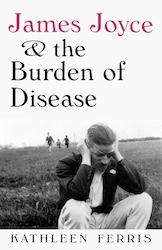
James Joyce and the Burden of Disease
By Kathleen Ferris
University Press of Kentucky, 1994
Available online at: Internet Archive Scholar
Publisher’s Description: James Joyce’s near blindness, his peculiar gait, and his death from perforated ulcers are commonplace knowledge to most of his readers. But until now, most Joyce scholars have not recognized that these symptoms point to a diagnosis of syphilis. Kathleen Ferris traces Joyce’s medical history as described in his correspondence, in the diaries of his brother Stanislaus, and in the memoirs of his acquaintances, to show that many of his symptoms match those of tabes dorsalis, a form of neurosyphilis which, untreated, eventually leads to paralysis. Combining literary analysis and medical detection, Ferris builds a convincing case that this dread disease is the subject of much of Joyce’s autobiographical writing. Many of this characters, most notably Stephen Dedalus and Leopold Bloom, exhibit the same symptoms as their creator: stiffness of gait, digestive problems, hallucinations, and impaired vision. Ferris also demonstrates that the themes of sin, guilt, and retribution so prevalent in Joyce’s works are almost certainly a consequence of his having contracted venereal disease as a young man while frequenting the brothels of Dublin and Paris. By tracing the images, puns, and metaphors in Ulysses and Finnegans Wake, and by demonstrating their relationship to Joyce’s experiences, Ferris shows the extent to which, for Joyce, art did indeed mirror life.
Introducing Joyce: A Graphic Guide
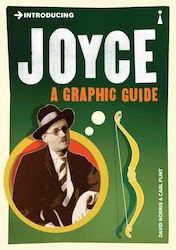
Introducing Joyce: A Graphic Guide
By David Norris and Carl Flint
Totem Books, 1994
Available online at: Internet Archive
This book is part of the Totem Books line of “Introducing X.” Delightful little works that incorporate comic illustrations, the series tackles some rather serious authors and topics, from Jacques Derrida, Jacques Lacan, and Stephen Hawking to “Genetics,” “Fascism,” and “Buddhism.” Though written as comic-book primers, they avoid condescension and the frenetic art is often clever and irreverent. Introducing Joyce was written by David Norris, an Irish senator, Trinity College Don, and internationally-known Joycean. The book details Joyce’s life and work, tracking Carl Flint’s long-nosed James from the cradle to the grave, and ends with a pair of Joyces discussing what they’ve learned about life: “That it’s sometimes bleak, more often comic, and desperately joyous.” It’s an enjoyable read for newbies and experts alike.
James Joyce: A Collection of Critical Essays
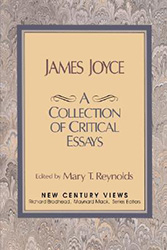
James Joyce: A Collection of Critical Essays
Edited by Mary T. Reynolds
Prentice Hall, 1994
Available online at: Internet Archive
Although Prentice Hall inexplicably gave this book the same title as its 1974 collection, this is an entirely different book, part of their “New Century Views.” As with the earlier collection, an eclectic mix of contributors has been selected: Joyceans old and new, critical philosophers, and literary lions such as Nobel laureate Seamus Heaney. It also contains Jacques Derrida’s famous piece, “Two Words for Joyce.”
Contents:
- Richard Ellman, “James Joyce In and Out of Art”
- Denis Donoghue, “The Fiction of James Joyce”
- David Hayman, “Language of/as Gesture in Joyce”
- Fritz Stein, “Joyce’s Misconducting Universe”
- Seamus Heaney, “Station Island”
- Bonnie Kime Scott, “Gender, Discourse, and Culture: Exiles”
- Phillip F. Herring, “The Trials of Adolescence”
- Cheryl Herr, “The Sermon as Massproduct: ‘Grace’ and A Portrait”
- Hugh Kenner, “O, an Impossible Person!”
- A. Walton Litz, “The Genre of Ulysses”
- Karen Lawrence, “Ulysses: the Narrative Norm”
- James A. Maddox, “Mockery in Ulysses”
- Fredric R. Jameson, “Ulysses in History”
- Maud Ellman, “To Sing or to Sign”
- Margot Norris, “Finnegans Wake: The Critical Method”
- Bernard Benstock, “Comic Seriousness and Poetic Prose”
- John Bishop, “Vico’s ‘Night of Darkness’: The New Science and Finnegans Wake”
- Jean-Michel Rabaté, “Narratology and the Subject of Finnegans Wake”
- Jacques Derrida, “Two Words for Joyce”
Molly Blooms: A Polylogue on “Penelope” and Cultural Studies
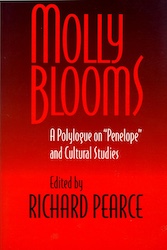
Molly Blooms: A Polylogue on “Penelope” and Cultural Studies
Edited by Richard Pearce
University of Wisconsin, 1994
Abstract of essays in this collection available at: Ricorso.net
Publisher’s Description: This is the first full-length critical study of Molly Bloom that attempts to bring her from the margin to the center of Ulysses. Twelve scholars, working from different points of view, look at “Penelope” through the lenses of cultural studies: feminism, new historicism, popular culture, postmodernism, and post-colonialism. As a result, they produce a multiplicity of Molly Blooms and illuminate the many positions she occupies in Joyce’s novel.
Contents:
- Kathleen McCormick, “Reproducing Molly Bloom: A Revisionist History of the Reception of Penelope, 1922-1970”
- Richard Pearce, “How Does Molly Bloom Look Through the Male Gaze?”
- Cheryl Herr, “Penelope as Period Piece”
- Kimberley J. Devlin, “Pretending in Penelope: Masquerade, Mimicry, and Molly Bloom”
- Carol Shloss, “Molly’s Resistance to the Union: Marriage and Colonialism in Dublin, 1904”
- Susan Bazargan, “Mapping Gibraltar: Colonialism, Time, and Narrative in Penelope”
- Brian W. Shaffer, “Negotiating Self and Culture: Narcissism, Competing Discourses, and Ideological Becoming in Penelope”
- Joseph Heininger, “Molly Bloom’s Ad Language and Goods Behavior: Advertising as Social Communication in Ulysses”
- Jennifer Wicke: “Who’s She When She’s at Home?: Molly Bloom and the Work of Consumption”
- Garry Leonard, “Molly Bloom’s ‘Lifestyle’: The Performative as Normative”
- Margaret Mills Harper, “Taken in Drapery: Dressing the Narrative in the Odyssey and Penelope”
- Ewa Ziarek, “The Female Body, Technology, and Memory in Penelope”
James Joyce A to Z: The Essential Reference to His Life and Writings
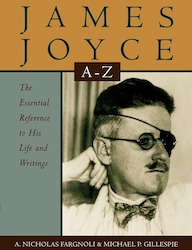
James Joyce A to Z: The Essential Reference to His Life and Writings
By A. Nicholas Fargnoli & Michael Patrick Gillespie
First Edition, Joyce A to Z: The Essential Reference to the Life and Work: Facts on File, 1995
Second Edition: Oxford University Press, 1996
Available online at: Internet Archive
Publisher’s Description: James Joyce A to Z is an encyclopedic companion and guide to Joyce’s work and life. All the major works are explicated and put in biographical and historical context; the book presents and explains the important terms, people, places and concepts necessary to an understanding of Joyce. There are biographical entries on Joyce and his family and immediate circle; discussions of Joyce’s intellectual and literary influences; entries on all major characters in his fiction; synopses and publishing histories of all his works; profiles of his peers and contemporaries; and accounts of the censorship battles and legal travails of Dubliners and Ulysses. James Joyce A to Z is meant to be of use even to scholars, but is written primarily for the reader first encountering Joyce. In a clear, concise and accessible fashion, this book supplies the basic cultural, historical, biographical and critical information necessary for the appreciation and enjoyment of Joyce’s work. James Joyce A to Z is structured for easy access, with over 800 A-to-Z entries, appendices, an extensive index and bibliographies. Its accessibility and comprehensiveness recommend it to the advanced student and the general reader alike.
Bloom’s Old Sweet Song: Essays on Joyce and Music
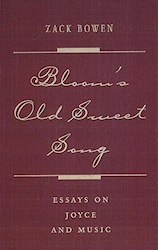
Bloom’s Old Sweet Song: Essays on Joyce and Music
By Zack Bowen
University Press of Florida, 1995
A collection of eight essays written by the inimitable Zack Bowen about Joyce and music. Cheryl Temple Herr published a glowing review of Bloom’s Old Sweet Song in the Journal of English and Germanic Philology: “In a sense, Bowen plays the music for us that Joyce conducts, indicating where readers must turn to individual interpretation and where the musical patterns take the lead. This is a volume full of gracenotes and well worth reading, particularly if the reader has been previously addicted to the thrill of discovery à la Joyce.”
Publisher’s Description: James Joyce used music and musical allusion in ways that no other writer has attempted. Ulysses alone contains more than 800 song references, many as dependent upon music as lyrics. In these retrospective essays, Zack Bowen, the leading expert on Joyce and music, describes this bond between music and Joyce’s fiction, explaining how musical allusions inform both individual passages and the theme or structure of entire works.
Modernism’s Body: Sex, Culture, and Joyce
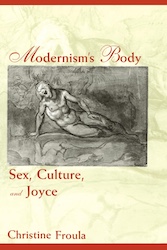
Modernism’s Body: Sex, Culture, and Joyce
By Christine Froula
Columbia University Press, 1996
Interested visitors may read two reviews of Froula’s book, one by Suzette Henke published in the James Joyce Quarterly, and one by Bonnie Kime Scott published in Modernism/modernity.
Publisher’s Description: A study of the work of James Joyce, by feminist scholar Christine Froula, this work is a reading of his critique of the origins and workings of gender in Western culture. It sees Joyce’s work as largely self-diagnostic, seeking to discover the masculine psyche of Western culture.
Joyce, Chaos & Complexity
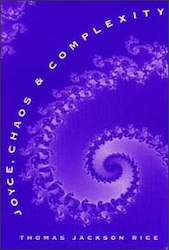
Joyce, Chaos & Complexity
By Thomas Jackson Rice
University of Illinois Press, 1997
Available online at: Internet Archive
Derek Attridge published a review of Joyce, Chaos & Complexity in the South Atlantic Review: “No scientific treatise could be more elegantly organized. As well as being well-ordered, Rice’s book is engaging and often informative; but for this reader, at least, it is finally unconvincing…”
Publisher’s Description: Thomas Rice compellingly argues that James Joyce’s work resists postmodernist approaches of ambiguity: Joyce never abandoned his conviction that reality exists, regardless of the human ability to represent it. Placing Joyce in his cultural context, Rice first traces the influence of Euclidean and non-Euclidean geometries on Dubliners and A Portrait of the Artist as a Young Man. He then demonstrates that, when later innovations in science transformed entire worldviews, Joyce recognized conventional literary modes of representation as offering only arbitrary constructions of this reality. Joyce responded in Ulysses by experimenting with perspective, embedding design, and affirming the existence of reality. Rice contends that Ulysses presages the multiple tensions of chaos theory; likewise, chaos theory can serve as a model for understanding Ulysses. In Finnegans Wake Joyce consummates his vision and anticipates the theories of complexity science through a dynamic approximation of reality.
Talking of Joyce
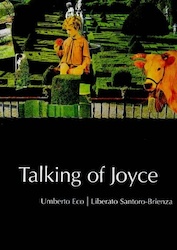
Talking of Joyce
By Umberto Eco & Liberato Santoro-Brienza
University College Dublin Press, 1998
Available online at: Internet Archive
This slim paperback contains the text of two lectures: “A Portrait of the Artist as a Bachelor” by Umberto Eco, and “Joyce’s Dialogue with Aquinas, Dante, Bruno, Vico, Svevo…” by Liberato Santoro-Brienza, the Statutory Lecturer in the Department of Philosophy at University College Dublin.
Publisher’s Description: These two lectures, delivered in Dublin by Umberto Eco and Liberato Santoro-Brienza, although highly respectful of Joyce, treat him on familiar terms as Jim. As Jim Mays writes in the Foreword: “Joyce is honored by being engaged, argued against and sympathised with. He provokes lines of enquiry which are shown to be worth following and to have provided jokes worth capping. These commentaries, by Italians in English, on an author of books in English who preferred to speak Italian, are a rich and illuminating conjunction. Read these lectures for the way they are, for they bring together two worlds. Their eminent authors do not stand on dignity: they communicate directly what is important. They have different things to say, but each celebrates values which Joyce held most dear.”
Joyce: Feminism / Post / Colonialism
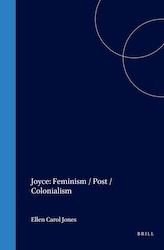
Joyce: Feminism / Post / Colonialism
Edited by Ellen Carol Jones
Brill Rodopi, 1998
Jennifer Frasier published a review of Joyce: Feminism / Post / Colonialism in the James Joyce Literary Supplement: “In this collection of essays, in which each one tends to reinforce the impact of the one that went before, the reader learns how intimately and disturbingly connected are conquered women and conquered lands.”
Publisher’s Description: James Joyce is located between, and constructed within, two worlds: the national and international, the political and cultural systems of colonialism and postcolonialism. Joyce’s political project is to construct a postcolonial contra-modernity: to write the incommensurable differences of colonial, postcolonial, and gendered subjectivities, and, in doing so, to reorient the axis of power and knowledge. What Joyce dramatizes in his hybrid writing is the political and cultural remainder of imperial history or patriarchal canons: a remainder that resists assimilation into the totalizing narratives of modernity. Through this remainder—of both politics and the psyche—Joyce reveals how a minority culture can construct political and personal agency. Joyce: Feminism / Post / Colonialism, edited by Ellen Carol Jones, bears witness to the construction of that agency, tracing the inscription of the racial and sexual other in colonial, nationalist, and postnational representations, deciphering the history of the possible.
Contents:
- Ellen Carol Jones, “Borderlines”
- Peter Hitchcock, “Joyce’s Subalternatives”
- James Fairhall, “Northsiders”
- Ranjana Khanna, “Araby: Women’s Time and the Time of the Nation”
- Carol Shloss, “Behind the Veil: James Joyce and the Colonial Harem”
- Gregory Castle, “Colonial Discourse and the Subject of Empire in Joyce’s Nausicaa”
- Susan de Sola Rodstein, “Back to 1904: Joyce, Ireland, and Nationalism”
- Marilyn Reizbaum, “Joyce’s Grand Nationals”
- Gerald Doherty, “Imperialism and the Rhetoric of Sexuality in James Joyce’s Ulysses”
- Enda Duffy, “Molly’s Throat”
- David Spurr, “Fatal Signatures: Forgery and Colonization in Finnegans Wake”
- Patrick McGee, “Masculine States and Feminine Republics: Finnegans Wake as Historical Document”
Bronze by Gold
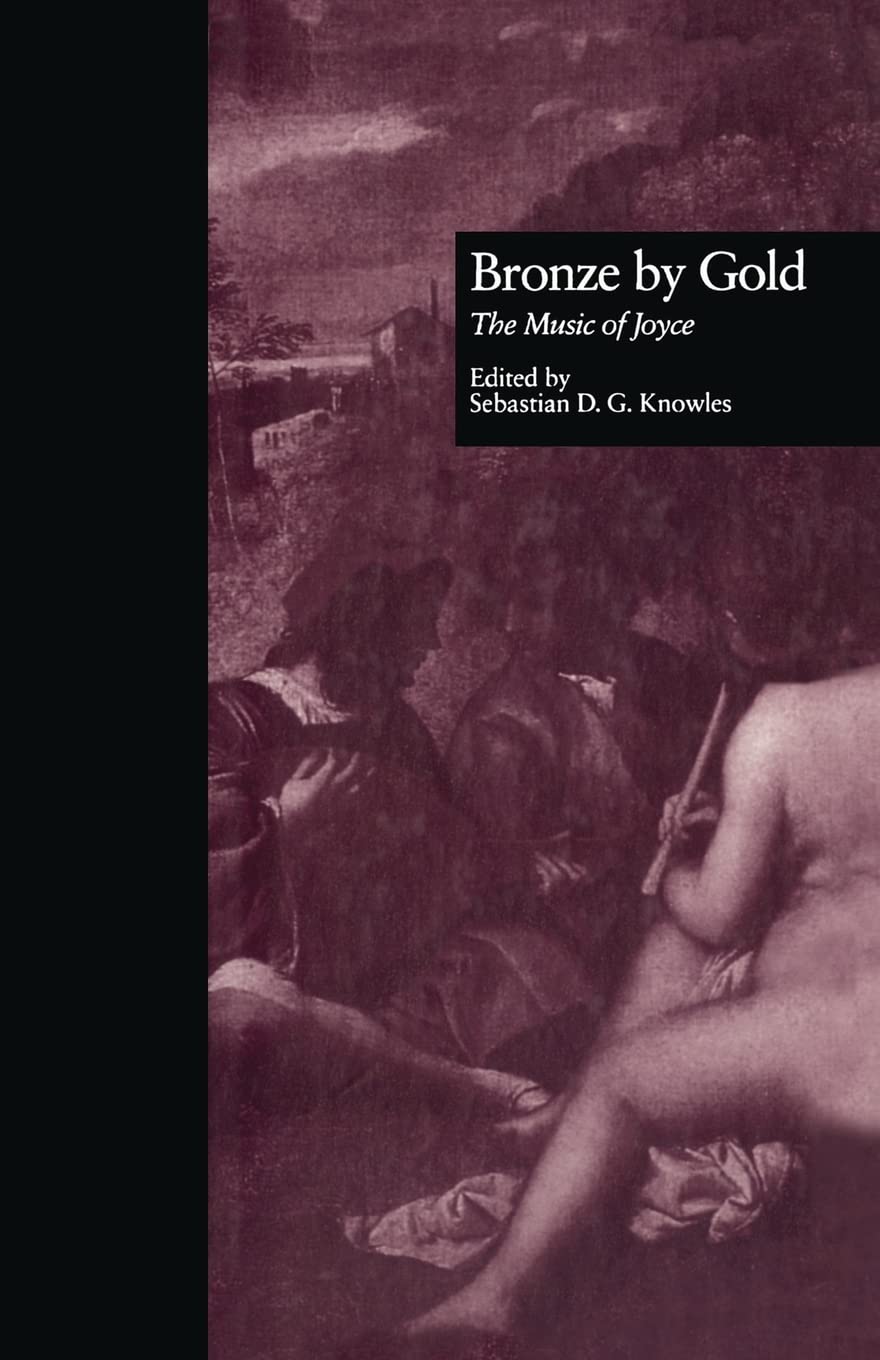
Bronze by Gold
Edited by Sebastian D.G. Knowles
Garland Publishing, 1999
Publisher’s Description: The contributors to this volume investigate several themes about music’s relationship to the literary compositions of James Joyce: music as a condition to which Joyce aspired; music theory as a useful way of reading his works; and musical compositions inspired by or connected with him.
Contents:
- Seamus Reilly, “James Joyce and Dublin Opera 1888-1904”
- John McCourt, “Joyce’s Trieste: Città Musicalissima”
- Myra T. Russel, “Chamber Music: Words and Music Lovingly Coupled”
- Paul Martin, “Mr. Bloom and the Cyclops: Joyce and Antheil’s Unfinished Opéra Mécanique”
- Sebastian D. G. Knowles, “Opus Posthumous: James Joyce, Gottfried Keller, Othmar Schoeck, and Samuel Barber”
- Scott W. Klein, “The Euphonium Cagehaused in Either Notation: John Cage and Finnegans Wake”
- Murat Eyuboglu, “Davies, Berio, and Ulysses”
- Allan Hepburn, “Noise, Music, Voice, Dubliners”
- Thomas Jackson Rice, “The Distant Music of the Spheres”
- Susan Mooney, “Bronze by Gold by Bloom: Echo, the Invocatory Drive, and the ‘Aurteur’ in Sirens”
- Andreas Fischer, “Strange Words, Strange Music: The Verbal Music of Sirens”
- Margaret Rogers, “Mining the Ore of Sirens: An Investigation of Structural Components”
- John Gordon, “Circe, La Gioconda, and the Opera House of the Mind”
- Zack Bowen and Alan Roughley, “Parsing Persse: The Codology of Hosty’s Song”
- Daniel J. Schiff, “Synthesizing ‘The Ballad of Persse O’Reilly’”
CONTINUE TO > General Joyce Criticism 2000-2019
Joyce Criticism
[Main Page | General Criticism | Dubliners | Portrait | Ulysses | Finnegans Wake]
Author: Allen B. Ruch & Bob Williams
Artwork: Loui Jover
Last Modified: 19 June 2024
Main Joyce Page: The Brazen Head
Contact: quail(at)shipwrecklibrary(dot)com

